 We knew by personal experience how exciting safaris could be in popular destinations like Tanzania, Kenya or South Africa. The opportunity of a scenic tour of Sri Lanka made us realize that what we had seen in Africa was nothing compared with what this island had to offer to the nature lover. The leading national parks in Sri Lanka are Yala and Minneriya, both located conveniently quite close to Colombo by relatively slow, yet scenic roads. 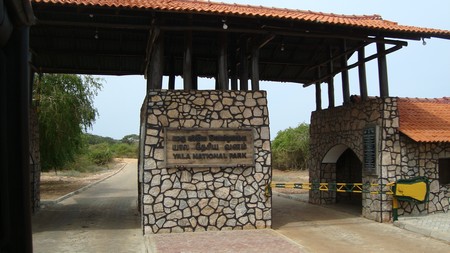 YALA NATIONAL PARK: The distance from the capital city to the entry point of the most visited and second largest national park in Sri Lanka., at Palatupana (near Kirinda), is 300 kilometers. Covering 979 sq. kilometers in the SE region, this wildlife sanctuary since 1900 extends over the districts of Monaragala and Hambantota. This is dry, in this astonishingly arid part of the green, tropical island. Since the 2004 tsunami, which killed 250 people in the vicinity, and ruined part of the touristic infrastructure along the splendid south coast, the climate suddenly changed. It became particularly hot. Expect 35 – 40° during the dry season starting in February, and sometimes covering not less than 10 months per year, without a single drop of rain! The inter-monsoonal rains, usually occurring in March or April, didn't show up in 2017 (date of our visit). This is a major issue for the locals... and the flora and fauna. Annual winter rainfall from the NE monsoon is expected between from November to January to bring more lush to the surviving trees and cracked soils. 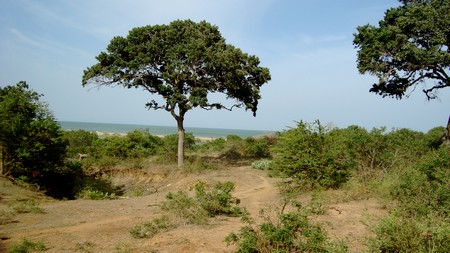 Despite the natural weather dysfunction, Yala remained an awesome place, with stunning panoramas and such a developed fauna. Carefully preserved by the government: contrary to South Africa or Tanzania, wealthy hunters from overseas are not welcome in the park. Once harmful, the ocean now preserves the animal with its regular breeze, infiltrated water filling the lakes and pounds, and feeding the trees and plants. Thanks to the intervention of Mister DJ, excellent driver-guide provided by Blue Lanka Tours, the preferred tour operator in the country, a new and clean, comfortable Toyota 6-seater jeep with soft top, came to pick us up directly at the door of one of the basic yet delicious restaurants where a solid lunch is recommended before the safari lasting at least 3 or 4 hours. This is a strict minimum to see a portion of the five blocks (only two are open to the public) constituting Yala National Park. We won't complain, as the safari was just a part of the rich tour designed by our agent, and as we have been extremely lucky, indeed: coming at the right moment and at the right places to mate in a short time what other visitors won't see in a one week closer observation. To experience the best of Yala, dawn and dusk bring about the best timing to observe the animals and to shoot impressive pictures of the savanna and desert beaches along the relatively still ocean. 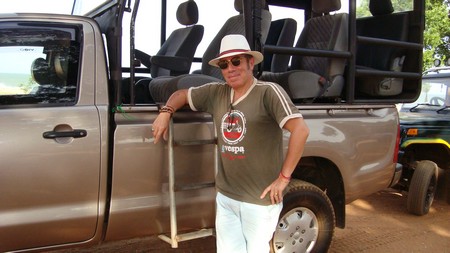 After checking-in at Palatana visitor center, with a basic canteen where we purchased enough water (we suggest at least 2 liters per person) and provisions for the half day safari, we boarded our jeep. Blue Lanka Tours managed one vehicle only for us: so that we could ask our tracker, echoing our orders to the driver, to stop anywhere and as long as we wished. If trackers are excellent, drivers tend to be quite impatient to show you as much as they can in a relatively short time. If you chose a 4 hours safari, get prepared for a race on the bumpy, dusty paths. And to some frustrations, not to say anger. A few minutes after we crossed the main gate of the park, our tracker explained that he could promise close encounters with wild elephants, crocodiles, monkeys, wild boars, rare birds and, very eventually, leopards. We could, by miracle see some sloth bears (Melursus ursinus). There are only 16 of them on the Island. 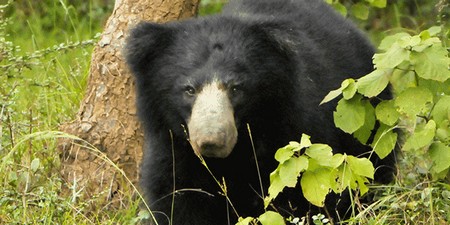 At this very precise moment, a mother and her two babies crossed the paths. Slowly, peacefully. Behaving like Schumacher, the driver ran full speed in their direction, shouting: “-Black bears! Black bears!”, covering the deafening symphony of the powerful engine. They escaped, of course. Two minutes later, after another unexpected encounter with the same bears, he maneuvered the same stupid way. We got blurred pictures, and felt so frustrated. Our kind tracker calmed us down: “-Sir, this is the first time in a 9 years career that we could see a group of three bears. That was such an excitement that the driver wanted to bring us closer.”. That was also, according to the local tradition, a great piece of luck. We saw them, and that was better than nothing. Surely a great privilege. But next time we undergo such a safari, we shall definitely ask the driver to make it as smooth as silk when he sees some rare species. 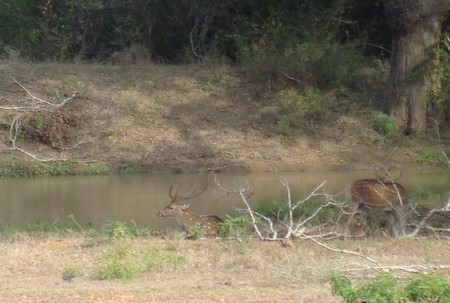 Crossing awesome moist monsoon forests, freshwater, and marine wetlands, a pleasure for the photographer at sunset or sunshine, moreover when we reach the virgin yellow sand beaches along the blue waters of the Indian Ocean, we were impressed by the omnipresence of birds. There are 215 species harbored in Yala. We could observe grey hornbills, grey herons, quite a lot of jungle-fowls, white pelicans and spot-billed pelicans. The pounds and sea shore attract lesser flamingos, and pelicans, night and purple herons, egrets, and many others. Ornithologists from around the world come to visit this IBA (Important Bird Area). 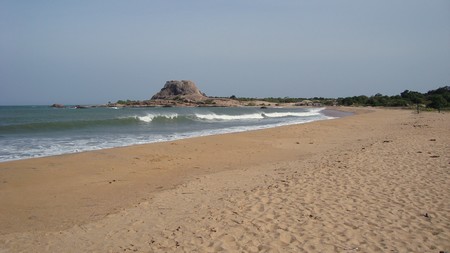 We like crocodiles. They share the pounds with the birds, peacefully, until they need some snacks... We could approach them at a 50 - 100 meters distance. We often spot them thanks to our tracker, as we hardly distinguished them from tree trunks. The saltwater crocodile is the most impressive. Actually one of the largest riparians and terrestrial predators in the world. Those at Yala weight up to one ton, for a length of 5 till 6 meters when adult. Particularly dangerous, this monster didn't give us the envy to take a bath in the scenic ocean where he likes to hunt fishes and crustaceans. The mugger crocodile avoids its larger brother. Concentrated in the marshes, we could photograph a few of them. They are also quite hard to spot. It has a broad snout, giving it an alligator-like appearance. Also called Indian or Sindhu crocodile, this is a common species in India, Pakistan, and Sri Lanka.  Due to the presence of dangerous species, including poisonous reptilians like the dreaded Indian Cobra, Russell's Viper, or Sri Lankan Krait (locally referred as “mudu karawalaa”). The “Flying Snake” is a curiosity of Sri Lanka (and India alike). It glides, by stretching the body into a flattened strip using its ribs. Though the park has one of the highest leopard densities in the world, its population is declining; though perfectly protected and fairly well reproducing in Yala. It has been much affected by the brutal post-tsunami modification of the weather. There are still 250 leopards in the park, and the longer your safari, the most chance you will get to mate one of them. 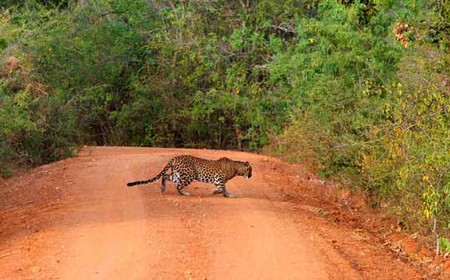 You will be sure to meet repeatedly groups of peaceful elephants. A mother prevented its baby from approaching our jeep for some food. What a difference with Krüger or Pilanesberg national parks in South Africa, where usually aggressive elephants can be remotely observed, tracked by armed rangers. The local elephant resembles the inhabitants of the island: peaceful and social, it would only attack in case of emergency to protect itself or its babies. We would say that we mated more elephants than in Minneriya, highly reputed for the abundance of pachyderms. 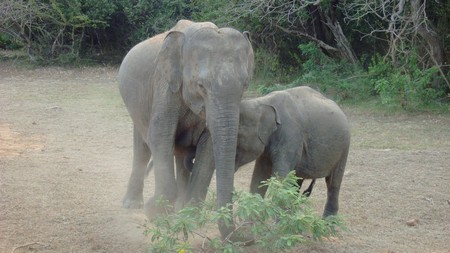 LODGING IN YALA: As already mentioned, lots of tourist resources, including lodges, have been destroyed by the tsunami. Lots still awaiting for a reconstruction. It is nevertheless quite easy to find comfortable and clean lodging not far from the park. Not an area for backpackers, safaris are rather an attraction for the happy few. Hotels reflect the tendency. Unless you book quite far in advance, or very last minute, you'd consider a solid budget. 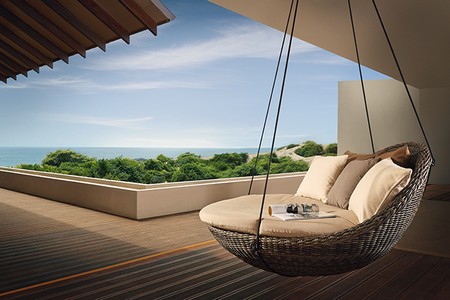 Our preference goes to Jetwing Yala. Sri Lanka’s premier resort brand and a leading name among Sri Lanka hotels, with 31 distinctive properties spread around the country, we selected Jetwing Hotels for accommodating most of our tour. Principally because all its properties are fully eco-responsible. The “Sustainability Strategy” by Jetwing features revolutionary systems: providing, for instance, more than 50% of its hotels' energy with steam-machines, powered by the combustion of cinnamon wood. And the other 50% using a developed solar-pannels system. Have a look at it if you stay with them: this is unique, clean with an odorant steam emanating from the chimney. Reputed for its cuisine, Ayurvedic SPA, meditation, an anticipating service, Jetwing occupies the best location. In Yala, for instance: on the borders of the national park, spreading across 38 acres of land, providing an awe-inspiring wildlife, a wellness center, and unparalleled, immaculate sand-beach, and a lovely pool with a scenic view of the Ocean. We liked the parquet floored rooms, with four-poster beds and all the five-star facilities. “The Dining Room” restaurant serves delectable curries and further local specialties. It has also an Asian fusion fine dining restaurant, “Thamapanni”. 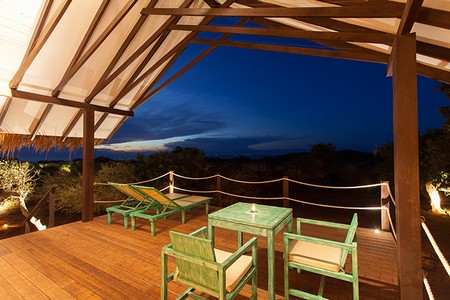 If you want to make it 100% safari-style, straightly book in Jetwing Tented Villas. Managed by Jetwing Yala, this sprawling, harmonious space with individual tents set in woodlands is located beyond the precinct of the national park. You can be closer to nature: experience in style the spirit of the wilderness. This little paradise has a beach bar, and leads directly to the park. It is warmly recommended. 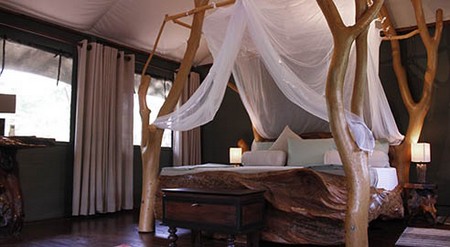 Noel Rodrigo's Leopard Safaris has a campsite in Yala. Made up of sedentary, yet stylish, South African tents completed with modern comfort and comfortable king sized beds., it ensures minimal impact on the park. It is located on a site selected for its natural beauty, and conveniently shaded areas of forest, which keep the temperature inside the tents cool and provide the guests with a much-needed respite from the sun. YALA NATIONAL PARK HOMEPAGE
NUWARA ELIYA "THE LITTLE ENGLAND" NEGOMBO: BEACH & TRADITION NEAR COLOMBO SAFARIS AND TOURS IN SRI LANKA JETWING HOTELS SRI LANKA TOURISM BOARD GETTING TO SRI LANKA WITH SRILANKAN AIRLINES BUSINESS CLASS 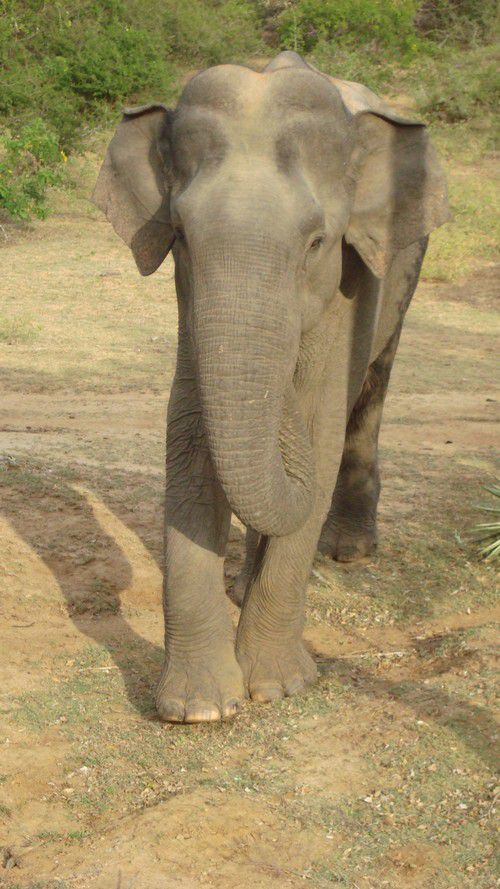 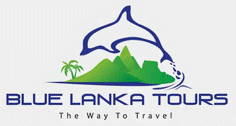   |



